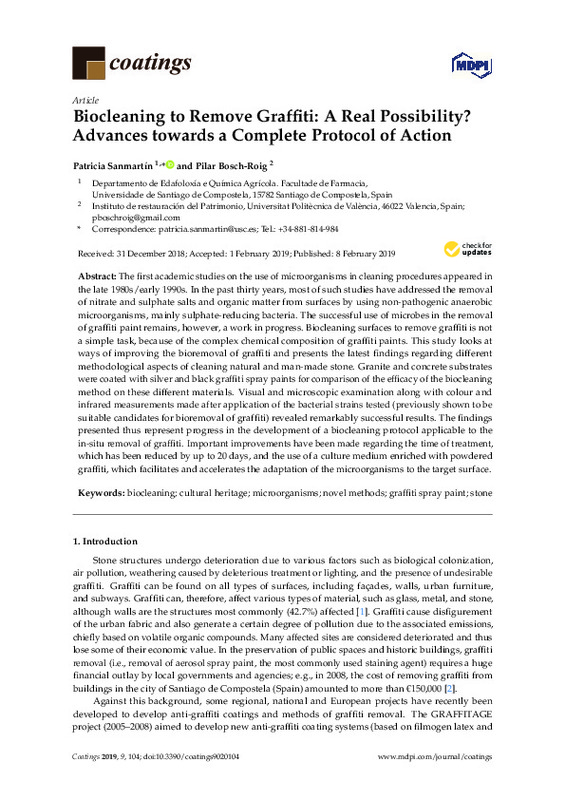JavaScript is disabled for your browser. Some features of this site may not work without it.
Buscar en RiuNet
Listar
Mi cuenta
Estadísticas
Ayuda RiuNet
Admin. UPV
Biocleaning to Remove Graffiti: A Real Possibility? Advances towards a Complete Protocol of Action
Mostrar el registro sencillo del ítem
Ficheros en el ítem
| dc.contributor.author | Bosch-Roig, Pilar
|
es_ES |
| dc.contributor.author | Sanmartín, Patricia
|
es_ES |
| dc.date.accessioned | 2019-06-09T20:25:38Z | |
| dc.date.available | 2019-06-09T20:25:38Z | |
| dc.date.issued | 2019 | es_ES |
| dc.identifier.uri | http://hdl.handle.net/10251/121858 | |
| dc.description.abstract | [EN] The first academic studies on the use of microorganisms in cleaning procedures appeared in the late 1980s/early 1990s. In the past thirty years, most of such studies have addressed the removal of nitrate and sulphate salts and organic matter from surfaces by using non-pathogenic anaerobic microorganisms, mainly sulphate-reducing bacteria. The successful use of microbes in the removal of graffiti paint remains, however, a work in progress. Biocleaning surfaces to remove graffiti is not a simple task, because of the complex chemical composition of graffiti paints. This study looks at ways of improving the bioremoval of graffiti and presents the latest findings regarding different methodological aspects of cleaning natural and man-made stone. Granite and concrete substrates were coated with silver and black graffiti spray paints for comparison of the efficacy of the biocleaning method on these different materials. Visual and microscopic examination along with colour and infrared measurements made after application of the bacterial strains tested (previously shown to be suitable candidates for bioremoval of graffiti) revealed remarkably successful results. The findings presented thus represent progress in the development of a biocleaning protocol applicable to the in-situ removal of graffiti. Important improvements have been made regarding the time of treatment, which has been reduced by up to 20 days, and the use of a culture medium enriched with powdered graffiti, which facilitates and accelerates the adaptation of the microorganisms to the target surface. | es_ES |
| dc.description.sponsorship | The authors are grateful to Barrie Foundation for the economic support in the purchase of some of the bacterial strains used in the study. The strains were purchased during the period of a scholarship for postgraduate studies abroad (2012 Call) granted to P. Sanmartin. | es_ES |
| dc.language | Inglés | es_ES |
| dc.publisher | MDPI AG | es_ES |
| dc.relation.ispartof | Coatings | es_ES |
| dc.rights | Reconocimiento (by) | es_ES |
| dc.subject | Biocleaning | es_ES |
| dc.subject | Cultural heritage | es_ES |
| dc.subject | Microorganisms | es_ES |
| dc.subject | Novel methods | es_ES |
| dc.subject | Graffiti spray paint | es_ES |
| dc.subject | Stone | es_ES |
| dc.subject.classification | PINTURA | es_ES |
| dc.title | Biocleaning to Remove Graffiti: A Real Possibility? Advances towards a Complete Protocol of Action | es_ES |
| dc.type | Artículo | es_ES |
| dc.identifier.doi | 10.3390/coatings9020104 | es_ES |
| dc.rights.accessRights | Abierto | es_ES |
| dc.contributor.affiliation | Universitat Politècnica de València. Departamento de Conservación y Restauración de Bienes Culturales - Departament de Conservació i Restauració de Béns Culturals | es_ES |
| dc.description.bibliographicCitation | Bosch-Roig, P.; Sanmartín, P. (2019). Biocleaning to Remove Graffiti: A Real Possibility? Advances towards a Complete Protocol of Action. Coatings. 9(2). https://doi.org/10.3390/coatings9020104 | es_ES |
| dc.description.accrualMethod | S | es_ES |
| dc.relation.publisherversion | https://doi.org/10.3390/coatings9020104 | es_ES |
| dc.description.upvformatpinicio | 104 | es_ES |
| dc.type.version | info:eu-repo/semantics/publishedVersion | es_ES |
| dc.description.volume | 9 | es_ES |
| dc.description.issue | 2 | es_ES |
| dc.identifier.eissn | 2079-6412 | es_ES |
| dc.relation.pasarela | S\379765 | es_ES |
| dc.contributor.funder | Fundación Barrié |








